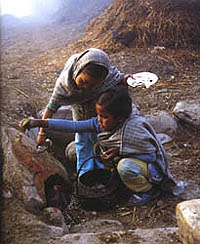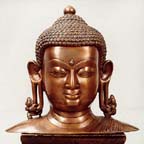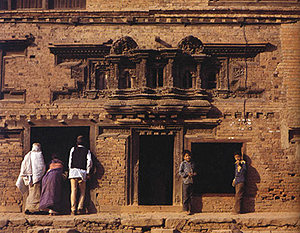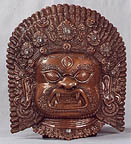Art and Religion in Nepal
Nepalese expressions of art, classical and modern, are imbedded in the daily practice of religion.
Unique craftsmanship is most easily found in temples, architecture, shrines, fountains and the design of religious objects. Understanding 
the various religious creeds as well as the representations of gods
and goddesses enhances the appreciation of Nepalese art.
boasts tremendous religious tolerance of the many faiths practiced
within its borders.
- Hinduists predominate in Nepal as 86.5% of
the population. - The next largest religious groups consist of
Buddhists, 7.8%, and - Muslims, 3.5% of the population.

Common
to all of these religions is the integration of religious expression
within everyday life. In contrast with Western religions, these
religions involve codes for- individual behavior and daily rites
of worship. In the morning, people gather at temples, sanctuaries
or river banks to offer prayers and puja.
(Hinduism in Nepal)
The word Hinduism was introduced in the 19th century to define the
aggregate beliefs of the Arya, immigrants who left Central Asia
in 1500 BC, and animist religions of native populations in India.
Basic concepts. Cosmic law rules the good order
of the world, be aware and respect cosmic law. Lead the life of
a good Hindu, observe rules, perform all rites, accept the caste
of birth. Caste system supplies code of conduct and rites done.
Encompasses all parts of life; rites but also who to take drink
from, associate with, marry, etc.
Principles of Hinduism: Dharma religious law and
moral code by which people can earn enlightenment. Karma is the
life balance of action and reaction; individuals responsible for
decisions and consequences. Leading good Hindu life will bring rebirth
into a better life. Samsara is cycle of reincarnations determined
by karma. Moksha is liberation from samsara; individual unites with
universal timelessness, ultimate serenity, nirvana. Path to moksha
is good Hindu life.
Each deity has different names, as well as different
symbols, attributes, tasks and powers according to what god it represents.
Each deity has a vehicle, an animal usually which serves master.
Primary Hindu gods are Brahma, Vishnu and Shiva.
Brahma
is the creator of the universe. Attributes are the rosary, the receptacle
of holy water, the ladle and the book. Mount is a goose or swan.
Brahma usually represented with four heads, allows him to watch
over world. Very few statues of Brahma since creation is done.
Saraswati
is Brahma's consort and is goddess of knowledge, learning and music.
She is often portrayed with four arms, plying the veena (seven stringed
musical instrument) with two hands as well as holding a rosary and
a book. Sits on a lotus riding a peacock or a swan. Often a crescent
moon on forehead. Worshipped by Buddhists as a form of Manjushri,
the Bodhisattva of wisdom.
Vishnu
is the preserver of life and the world. Attributes are the conchshell,
the disc, the lotus and the mace. Mount is Garuda, a mythical half-man
and half-bird. He often appears in some of the following forms:
Narayan,
which means "he who guides development in all fields"
or universal knowledge.
Buddha,
ninth reincarnation of Vishnu.
Rama,
warrior who rescued wife Sita who had been taken by Ravan, demon-king
of Ceylon.
Krishna,
personification of manhood who bewitched 'gopis' (milkmaids and
shepherdesses) with whom he frolicked. Forms of Rama and Krishna
more popular in India.
Shiva,
the destroyer and regenerator. Attributes are the trident, the tambourine,
the tiger skin, the club, and the lingam. Mount is Nandi the bull.
Pashupati,
master and protector of animals, especially of cattle, who is the
friend of life.
Bhairav,
the form of Shiva eager to destroy everything, including evil. Usually
a black statue, with necklace of human skulls.
Hanuman,
the monkey god. Symbolizes faithfulness and willingness to help.
Associated with successful military undertakings and assisted Rama
in fight against demon-king Ravan who kept Ram's wife Sita imprisoned
for 12 years.
Ganesh,
(Ganapati) one of the most popular gods in Nepal. Infallible, charitable
and has power to decide fate of any human enterprise. Universal
power. Shiva and Parvati's son. Shiva was away, Parvati bore a son
while he was gone. Ordered son not to let anyone in. Shiva came
home, young guardsman barred him from entering so he chopped off
the guard's head with sword. Parvati terrorized, Shiva promised
to bring him back to life by beheading the first living creature
he found in the forest. Saw elephant first, so cut off its head,
rushed back and put it on Ganesh's head. Ganesh always dressed in
red, four arms and body covered with layers of sandalwood paste.
Only one tusk, mount is a shrew, sometimes mistaken for rat or mouse.
Consequently all three are sacred.
Parvati,
Shiva's consort. In benevolent forms, Devi, Uma, Shakti or Annapurna
as the "dispenser of abundance." As wreaking havoc, forms
of Kali, Durga or Bhagavati.
Based on meditations of GAUTAMA SIDDHARTA, also called Sakyamuni
(wise man of the Sakya clan) and later the Buddha (Enlightened one).
Philosophical doctrine and code of conduct. Based on the three jewels,
Buddha himself, dharma, Buddha's teachings and prescribed conduct,
and sangha the community.
Buddha
was born in Lumbini, Nepal around 544 BC. Son of raja (title for
rulers and wealthy landlords) who sought reason for human misery.
Left his family and experimented and traveled; found enlightenment
through meditation at Bodh Gaya.
Dharma
is the doctrine of four truths discovered through meditation.
Existence is unhappiness.
- Everything in life brings suffering, birth,
responding to needs and death. Origin of suffering is in needs,
wants and desires of men and being attached to material values
(illusions of the senses). - Unhappiness is caused by selfish cravings
or passions. - Selfish cravings can be eliminated by renunciation
desires and following the eight-fold path:
1. Right views, understanding and vision
2. Right purpose, aspiration and intention
3. Right speech
4. Right vocation and honest livelihood
5. Right conduct and action
6. Right effort and dedication
7. Right alertness and mindfulness
8. Right concentration and meditation.
Sangha
is community of Buddhists. Used to mean monastic community but concept
broadened. Showing the path to enlightenment.
About 100 years after Buddha's death, communities
disagreed and split over ways to achieve enlightenment. Traditional
school of Theravada Buddhists follows Buddha's original teachings.
Mahayana school accepts some changes, various ways to enlightenment
(became Zen).
Scripts appeared also introducing changes. Deification
of Buddha, and separation between mortal Buddha like Siddharta who
will reappear, and transcendental ones which are only understood
through meditation (Dhyani Buddhas). While enlightenment reached
through individual effort, idea spread that meditation Buddhas give
merit to those who worship them. Bodhisattvas are humans who reached
enlightenment but instead of joining nirvana chose to help others
reach enlightenment.
Movement from with the Mahayana school appeared in first century
AD in fringe areas of India. Hindus and Buddhists came into contact
with animist religions and integrated beliefs and practices. Yoga,
physical exercises to control body functions, mantras, repetitive
utterances, bijas, magic syllables, use of designs and objects such
as mandala and dorje. Transformed into Lamaism which penetrated
also into Nepal. Purpose was to shorten the road to enlightenment
with such practices.
Prayer Flags and Prayer Wheels take
prayers to the sky, to the divinities. Idea that movement creates
power. Prayer wheels rotated clockwise to send mantra to the divinities.
Usually brass cylinder with pre-Sanskrit script, ranja, writing.
The wheel contains parchment like paper upon which the Tibetan incantation
OM MANI PADME HUM (image
top) is repeatedly
printed. Some rough translations of this mantra are
Oh, the jewel (mani) concealed in the lotus
(padma) ah.
- One specific interpretation of this incantation
is that of a prayer the Boddhisattva Padmapani who controls reincarnation
Oh, Padmapani, give me the jewel in the lotus, which is the blessing
on non-rebirth or attainment of Nirvana through the acceptance
of the Buddhist doctrine. - A more general interpretation is
Oh, may the jewel remain in the lotus, meaning may Buddha's teachings
remain pure in our minds and souls.
two crowns with bases attached by a metal ball. Each crown has four
outer spokes and one inner spoke to represent the meditation Buddhas,
united at the top to convey that they are but one. Means "thunderbolt"
symbolic attribute of Hindu god Indra who is the divine power of
natural forces, and the "diamond", the substance that
is translucent and unbreakable. The Dorje is primarily a symbol
of power but is also a representation of the male.
Ghanta,
the bell is bronze and topped with crown shaped handle. The bell
symbolizes the female. In a metaphysical sense, male represents
knowledge and female represents wisdom. Both important to rituals.
Statues and temples for Buddha or to Bodhisattvas.
a somewhat conical stone structure, shrines for gratitude or worship.
Always show four statues representing each of the dhyana-Buddhas
or meditation Buddhas.
with right hand upward and palms outward to express fearlessness
and blessing (associated with green).
Facing east, Buddha Akshobya,
right hand outstretched with fingers touching earth calling Earth-goddess
to witness that Buddha resisted temptations put forth by demon Mara
who was trying to lure him away from his meditations. Also thought
of as calling to witness Buddha's deserving supreme enlightenment.
(blue)
Facing south, Buddha Ratnasambhawa
with right hand palm outward to express compassion. yellow
Facing west, Buddha Amithaba,
two hands folded, resting on lap in meditation. red.
Some chaityas or scrolls show a fifth central
figure, the Buddha Vairocana
who is above or in the middle of the previously mentioned four.
Hands folded in front of chest he is perfect sovereignty as "turning
the wheel of the Buddhist doctrine." white.
Another common Buddhist statue is that of the
Tara, either white
or green Tara. Were the two wives of Srong Tsam Gampo, King of Tibet
that they converted to their faith, Buddhism. Deified.
Bodhisattvas honored often are Padmapani,
holds a lotus flower and is master or reincarnations. Manjushri
is honored as bearer of wisdom by Buddhists and Hindus. Holds book
of knowledge in left hand and a sword to strike ignorance with right.
A historical look demonstrates that artistic expression
reflects the religious and ethnic diversity within the valley. Nepalese
art became prominent in the 13th century through the work of Balbahu,
also known as Arniko,
an architect for the king of Tibet and possibly the Emperor of China.
Nepalese art is recognized for its candour, simplicity and harmony
balanced with intricacy and decoration. The Malla dynasty promoted
all forms of artistic expression from the 14th to the 19th centuries.
Tibetan forms of expression influenced art in the valley beginning
in the 17th century. Tantric and Buddhist themes introduced greater
differentiation between Nepalese and Indian art.
People walking the streets of Kathmandu cannot fail to notice the
abundance of religious buildings in the city. Temples exist near
or around royal palaces, as well as at important geographical locations
including the top of hills, river banks or near wells. Private temples
were built anywhere and can be found in almost every neighbourhood.

The temples are sites of magnificent stone and
wood carvings. Most of the stone carvings are from the eleventh
and twelfth centuries and reflect the influence of Indian art from
the Gupta (5 and 6th century A.D.) and the Palasena (10th to 12th
century AD.) periods. Wood carvings are predominantly from the eighteenth
century used to decorate pillars, door and window frames, cornices
and supporting struts. Struts of Hindu temples usually contain an
erotic scene which attracts speculation from visitors. The motivation
for such motifs are natural; in countries where death is predominant,
procreation is sacred in some respects as the embodiment of life-giving
energies and fertility. Sexual union also represents the union of
the individual with the universe in the Vedas which are Hindu texts.
Temples are usually one of three types; pagodas,
shikaras or stupas. Stupas are exclusively a Buddhist temple, but
pagodas and shikaras may be Hindu or Buddhist. Buddhist temples
are almost always surrounded by a wall with a defined entrance way.
A wall of prayer wheels often surrounds the temple. Whether Hindu
or Buddhist, these temples are not places of religious gatherings
popular within Christianity and Muslim religions but are sites of
individual worship.
Pagodas (devala in Nepali) are usually square
or rectangular with a simple geometric design. The base of the temple
holds an image of the god honored by the presence of the temple.
The temple has several roofs which get proportionately smaller with
height. The number of roofs is usually odd, since odd numbers are
more auspicious than even numbers. Many scholars believe that the
pagoda style of roofing mimics the multi-tiered style of umbrellas
held over royalty or images of deities during processions. The building
is usually brick, although the foundation may consist of stone blocks.
The doors and windows are wood with latticed patterns for adornment.
A torana sits above the door, also of wood or bronze-plated wood,
depicting the triumph of good over evil with the image of a gryphon
holding in its grip a naga or kirtimukha. The struts of the temple
(tunal in Nepali), carved wooden brackets which support the projecting
roof eaves at a 45 degree angle, consist of a deity standing upon
a lotus flower above a decorative scene, often erotic, carved upon
the lower part of the strut. The struts in the corners of the pagoda
often depict a roaring lion or mythical animal which conveys power.
The roofs are plated with copper or gilded bronze and the corners
of the roofs always turn upward. These corners end in a human or
animal's head facing downward and a bird in flight on the upward
slant. A metal ribbon hangs from the topmost point almost to the
ground, symbolizing the path for the deity to descend to earth and
people to rise to the divine. Kinkinimala adorn the edge of the
roofs; unmoving bells with a thin metal clapper which tinkles against
the bell in the wind. One or two bronze bells also stand near the
entrance of the pagoda. Protecting this entrance are bronze or stone
images of dragons or lions. Mirrors often hang from a temple wall;
these are a modern addition to ensure that a woman's tika is neatly
placed in the center of her forehead. Examples of pagoda style temples
are the Taleju Mandir in Kathmandu's Durbar Square, the Golden Temple
in Patan and the Nyatapola in Bhaktapur.
Shikaras are similar in design to Indian temples,
best recognized by a majestic dome roof. Some describe the dome
as an unopened lotus flower or a folder royal umbrella. The base
of the temple is square with many stories of balconies. Two famous
shikaras are the Krishna Mandir and the Mahabuddha, both located
in Patan.
a cubic base with a spherical body and a towered roof. This design
mimics the mandala design, a cosmic representation of the universe
conducive to meditation. The cubic base symbolizes the earth's solidity,
the spherical mound symbolizes water, the tower is fire, the ring
above it air, and the crowned top symbolizes ether. Thirteen steps
between the mound and the tower represent the number of steps to
attaining perfect knowledge. Most of the stupa is painted masonry
white but the four sides of the tower hold the omniscient eyes of
Buddha. The eyes watch over the universe, and the symbol between
the two prominent eyes is the third eye which allows one to see
beyond and inside the self. The symbol in the typical position of
the nose is the Devanagari script for the number one, to remind
people that only one way exists to salvation. The stupas, designed
to hold remains or relics, are not hollow. People encircle stupas
by walking clockwise, often spinning prayer wheels embedded in the
wall surrounding the temple. Boudhanath and Swayambhunath, the largest
stupas in Kathmandu, are approximately 2000 years old.
The earliest paintings appeared in 11th century AD. and consisted
of illustrated manuscripts on palm leaf or rice paper. Thangkas,
a more predominant form of painting, are popular among Buddhists
in Nepal as well as in Tibet and date back to the late 14th century.
These paintings on cotton are rectangular in shape and usually longer
than they are wide. They are framed with three stripes of Chinese
brocade of blue, yellow and red which represent the rainbow which
separates sacred objects from the material world. Older Thangkas
consisted of mineral-based colors, while current Thangkas are produced
with vegetable-based or chemical colors. Frequent themes of Thangkas
include images of Buddhist figures, mandala designs, the wheel of
life design, or depiction of scenes or stories.
Mandalas are geometrical patterns which assist
in the practice of meditation, as well as symbolize the nature of
the universe. The symmetrical pattern reflects the development of
the cosmos from an essential Principle and its rotation around a
central axis.
Other Buddhist symbols are common to Thangkas
and wall paintings. A picture of four guardians may adorn the entrance
to a monastery; two images are benevolent to greet worshippers,
and two are fierce looking to protect against evil spirits. Other
symbols are the wheel of moral law, the umbrella to protect against
evil, the victory banner of Buddha's doctrine, two golden fish which
represent wealth, the endless knot of eternal re-birth of everything,
the flower-vase holding eternal bliss, the conch-shell proclaiming
the benefits of enlightenment, and the lotus flower which symbolizes
purity and the release of spirituality from earthly roots.
The fable of the four unanimous brothers involves
an elephant standing near a fruit-bearing tree with a monkey on
its back. The monkey holds a rabbit on its shoulder and a bird perches
on the rabbit. All hold a piece of fruit. The bird maintained that
while enjoying the shade and fruit of the tree, they owe gratitude
to him since he planted the seed of the tree. The rabbit replied
that while the bird sprinkles seed without regard, he watered the
seed daily and conscientiously. The monkey stated that it was his
dung, not the planting or the watering which was essential to the
seed's growth. The elephant acknowledged their contributions, but
said that it was his protection of the plant from other animals
which made the tree's growth possible. The moral of the story is
that cooperation causes fruitfulness.
The wheel of life symbolizes the endless cycle
of reincarnations. A demon holds the wheel with fangs and claws
to symbolize how repulsive it can be to participate in life. Buddha
is portrayed outside of the wheel standing erect since he reached
enlightenment and escaped the cycle of rebirth. The center of the
image is a circle which contains the three vices; the rooster symbolizes
lust, the snake symbolizes hatred, and the boar symbolizes ignorance.
A ring around this circle shows the six stages of reincarnation;
at the bottom is hell for the doomed, followed by the world of the
pretas which are greedy and slaves to their desires, the last inferior
world of the animals portrayed with a pastoral scene, the human
world of towns and villages, the world of the Titans which wage
war against the gods, and the world of the gods portraying beauty
and serenity. Another ring illustrates small images to teach a lesson;
a blind woman using a stick to walk symbolizes impulses created
from ignorance, the potter manifests these impulses with the focus
on feeling, a monkey picking up fruit represents the consciousness
of acting on impulses, men in a boat symbolize that consciousness
can create individuality but also separation, an empty house with
an open door represents sensory perceptions translated into action
by the mind (perceptions enter through windows but leave as actions
out the door), a couple embracing shows how sensory perception creates
physical desires, a man hit by an arrow demonstrates that touch
excites the senses with pain or pleasure, a woman filling a man's
cup shows that excitement of the senses creates a thirst for more,
a monkey grabbing for fruit shows desire becoming a demand for more,
the expecting mother shows that such eagerness for more is part
of existence, the child's birth demonstrates birth as a necessary
condition, and a man carrying a body shows death as a necessary
condition of existence.
Literature appeared in the valley during the 18th century. Poetry
is the predominant form of writing from this period, but most authors
are unknown. The following centuries brought more poets and writers
inspired by religion as well as social problems. Musical lyrics
celebrate the beauty of nature and life, or convey a legend.
Bronze figures, sometimes alloyed with copper, appeared in the valley around
8th century AD. These images usually represented religious deities
or legendary figures. The most frequently used production technique
is that of cire perdue, a form of wax casting. Images often contain embedded semi-precious stones, usually coral or turquoise, or are gilded with gold.
Jewelry of gold and silver reflects the preferences of ethnic groups.
Gurung women often wear large disc earrings of bronze and copper,
while Sherpa women often have turquoise and silver earrings. Other
forms of jewelry include nose rings, pendants, engraved silver belts,
anklets and bracelets.
Pottery flourishes in Patan and Thimi, a locality near Bhaktapur.
Common forms of pottery are terra cotta oil lamps used to light
homes during the festival Dipawali, and flower pots decorated with
peacocks and elephants.
People constantly express concern about the
preservation of art in the valley. Many temples and statues are
in various stages of disrepair. Two earthquakes, one in 1833 and
one in 1934, left a wake of destruction in the country. Until recently,
Nepal lacked people with the scientific knowledge required for artistic
restoration. Authorities also battle with the establishment of priorities;
financing the development of infrastructure and addressing social
and health concerns of the population detracts money from restoration
projects. Foreign aid projects specifically addressing the maintenance
of palace squares and other historical sites are becoming more popular
and provide valuable assistance in the preservation of Nepalese
art.

































